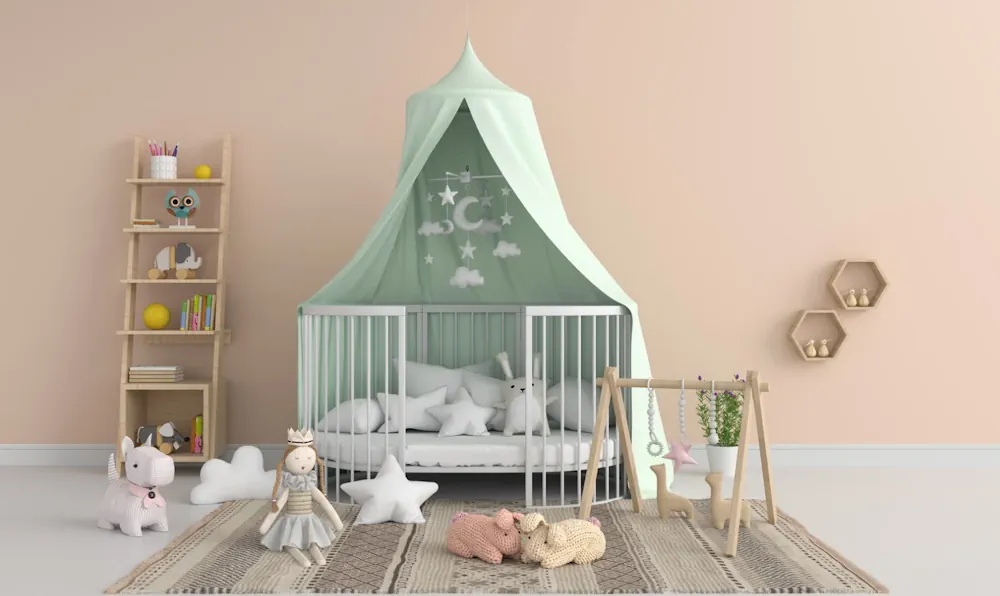
Maria Montessori emphasized the importance of creating an inspiring environment where a child can easily and pleasurably rest, learn, play, and acquire new skills. Montessori believed that a child has an “absorbent mind” that absorbs information from the surroundings, even beyond traditional educational activities. Every element has significance, and she not only provided guidance on organizing the space but also shared her vision of how children’s furniture should be. These principles are embodied in the kids’ full Montessori furniture set by Busywood.
Montessori furniture by Busywood is designed with a focus on a kid’s needs and aims to foster their development. This innovative concept allows children to discover the world around them independently, safely explore their environment, and learn through play.
Principles of Arranging a Child’s Room
The arrangement of a child’s room, according to Montessori philosophy, is based on several key principles that promote the harmonious development of toddlers.
- Children should have the opportunity to perform various tasks independently. Consequently, the organization of a child’s room should facilitate this independence. For example, low-profile or floor beds allow children to lie down and get up independently.
- A child’s room should be organized so that various toys, books, and materials are accessible to toddlers, allowing them to choose the items they want to work with and play with. This helps develop initiative and independence.
- It is crucial to stimulate activity and movement. A child should be able to climb, play, and explore the world around them. Different pieces of furniture, including children’s climbing frames, help develop physical skills.
- One of the essential aspects of Montessori is the organization of space and orderliness. A child’s room should be clean and well-maintained, with each item having its place. This promotes the development of independence skills and helps the child navigate the environment more easily.
Applying these principles when arranging a child’s room helps create a favorable atmosphere for the child’s harmonious development, fostering their comprehensive growth.
Zones in a Montessori Child’s Room
Another essential aspect of arranging a Montessori room is dividing the space into functional zones: a place for sleep and relaxation, an area for sports and various activities, and a zone for learning and creative activities. Each zone should have its furniture and materials tailored to a toddler’s needs.
- The sleeping area should be comfortable and safe. Low-profile beds with low sides are perfect for children of this age, as they allow little ones to get in and out of bed easily. It’s also important to choose high-quality bedding and add organizers for diapers and other essentials to keep everything within reach.
- The play area is a space where a toddler can move freely and play with sports equipment like climbing frames, balance beams, and more.
- The learning area should include bookshelves, a working desk, and educational materials that help toddlers learn through play and explore the world around them.
It’s also essential to provide a place for storing children’s clothes and other items, ideally allowing the child to use them independently. Montessori-inspired children’s wardrobes are low and not very deep to make it easy for children to choose their clothes for outings or keep their belongings in order. This not only offers convenience but also teaches the child about organizing space, tidiness, room organization, and independence.
Montessori Climbing Frames: What Are They, and Why Are They Important?
Why are specially designed children’s climbing frames used in almost every Montessori room? It’s because they are more than just furniture; they are structures that kids can use for climbing, physical activities, creative play, and relaxation. Primarily, they help children develop various physical skills, including flexibility, muscle strength, balance, and coordination.
Moreover, these climbing frames are constructed so that, through stimulation and massaging of specific points, children can relax and gain valuable sensory experiences. Due to the invaluable benefits they bring, these toys have gained immense popularity even among families who do not strictly follow Montessori principles in parenting but are looking for toys, furniture, and educational materials that both appeal to their child and provide invaluable benefits.
Summary
Montessori furniture in a child’s room is the key to harmonious toddler development. They allow for the creation of a comfortable environment for play, learning, and physical development. The toys and furniture in this room foster a learning-through-play atmosphere, develop physical and cognitive skills, and promote a child’s independence and self-sufficiency. So, let your child’s room become a place of great discoveries and unforgettable adventures.
Also Read:
- IND vs ENG: Jadeja, Sundar, Gill Hundreds Help India Earn Dramatic Draw Against England in 4th Test
- “If There Are No Bilateral Matches, Why Play in Multination Events?”: Azharuddin on India-Pakistan Asia Cup Clash
- Men’s Asia Cup 2025 To Be Held In UAE; ACC
- Ben Stokes Creates History With 11,000 International Runs And Rare 7,000 Runs-200 Wickets Test Feat




